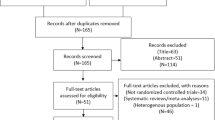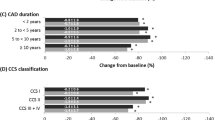Summary
Aim: We describe the safety profile of nifedipine GITS as assessed from adverse events reported in the ACTION trial in which 7,665 patients with stable, symptomatic coronary artery disease were randomly assigned nifedipine GITS or placebo and followed for a mean of 4.9 years. Methods: All adverse events were coded using the COSTART coding dictionary. The incidence rate for each event was calculated as the number of patients with the event concerned divided by the total time ‘at risk’. Hazard ratios comparing nifedipine with placebo and their 95% confidence intervals were obtained by Cox proportional-hazards analysis. Results: As reported previously, nifedipine significantly reduced the incidence of cardiovascular events and procedures [hazard ratio (HR) 0.89, 95% confidence interval (CI) 0.83–0.95]. Apart from the known side effects of nifedipine, which include peripheral oedema, vasodilatation, hypotension, asthenia, constipation, leg cramps, non-specific respiratory complaints, impotence and polyuria, and which were reported more frequently in patients assigned nifedipine, the incidence rates of most other adverse events were similar. There were no differences in the occurrence of gastrointestinal haemorrhage, myocardial infarction and suicide. The rate of occurrence of death or new cancer excluding non-melanoma skin cancer for patients with no history of cancer at baseline was 2.53/100 patient years for patients assigned nifedipine and 2.37/100 patient years for patients assigned placebo (HR 1.06, 95% CI 0.93–1.22). Conclusion: Overall nifedipine GITS was well tolerated by patients with stable symptomatic angina.
Similar content being viewed by others
References
Lenfant C. The calcium channel blocker scare. Lessons for the future. Circulation 1995;91:2855–2856.
Opie LH, Messerli FH. Nifedipine and mortality. Grave defects in the dossier. Circulation 1995;92:1068–1073.
Opie LH. Risks and benefits of calcium antagonists. Lancet 1995;346:961.
Horton R. Spinning the risks and benefits of calcium antagonists. Lancet 1995;346:586–587.
Poole-Wilson PA. The calcium antagonist controversy; implications beyond drug prescription. Eur Heart J 1996;17:1131–1133.
Kaplan NM. Do calcium antagonists cause myocardial infarction? Am J Cardiol 1996;77:81–82.
Kaplan NM. Do calcium antagonists cause death, gastrointestinal bleeding, and cancer? Am J Cardiol 1996;78:932–933.
McMurray J, Murdoch D. Calcium-antagonist controversy: The long and short of it? Lancet 1997;349:585–586.
Califf RM, Kramer JM. What have we learned from the calcium channel blocker controversy? Circulation 1998;97:1529–1531.
Lubsen J. The calcium channel antagonist debate: Recent developments. Eur Heart J 1998;19(Suppl I):I3–I7.
Stelfox HT, Chua G, O’Rourke K, Detsky AS. Conflict of interest in the debate over calcium-channel antagonists. N Engl J Med 1998;338:101–106.
Psaty BM, Heckbert SR, Koepsell TD,et al. The risk of myocardial infarction associated with antihypertensive drug therapies. JAMA 1995;274:620–625.
Furberg CD, Psaty BM, Meyer JV. Nifedipine. Dose-related increase in mortality in patients with coronary heart disease. Circulation 1995;92:1326–1331.
Pahor M, Guralnik JM, Corti MC, Foley DJ, Carbonin P, Havlik RJ. Long-term survival and use of antihypertensive medications in older persons. J Am Geriatr Soc 1995;43:1191–1197.
Furberg CD, Psaty BM. Should calcium antagonists be first-line agents in the treatment of cardiovascular disease? The public health perspective. Cardiovasc Drugs Ther 1996;10:463–466.
Pahor M, Guralnik JM, Ferrucci L,et al. Calcium-channel blockade and incidence of cancer in aged populations. Lancet 1996;348:493–497.
Pahor M, Guralnik JM, Salive ME, Corti MC, Carbonin P, Havlik RJ. Do calcium channel blockers increase the risk of cancer? Am J Hypertens 1996;9:695–699.
Pahor M, Guralnik JM, Furberg CD, Carbonin P, Havlik R. Risk of gastrointestinal haemorrhage with calcium antagonists in hypertensive persons over 67 years old. Lancet 1996;347:1061–1065.
Garcia Rodriguez LA, Cattaruzzi C, Troncon MG, Agostinis L. Risk of hospitalization for upper gastrointestinal tract bleeding associated with ketorolac, other nonsteroidal anti-inflammatory drugs, calcium antagonists, and other antihypertensive drugs. Arch Intern Med 1998;158:33–39.
Kaplan RC, Heckbert SR, Koepsell TD, Rosendaal FR, Psaty BM. Use of calcium channel blockers and risk of hospitalized gastrointestinal tract bleeding. Arch Intern Med 2000;160:1849–1855.
Lindberg G, Bingefors K, Ranstam J, Rastam L, Melander A. Use of calcium channel blockers and risk of suicide: Ecological findings confirmed in population based cohort study. BMJ 1998;316:741–745.
Opie LH, Yusuf S, Kubler W. Current status of safety and efficacy of calcium channel blockers in cardiovascular diseases: A critical analysis based on 100 studies. Prog Cardiovasc Dis 2000;43:171–196.
Kizer JR, Kimmel SE. Epidemiologic review of the calcium channel blocker drugs. An up-to-date perspective on the proposed hazards. Arch Intern Med 2001;161:1145–1158.
Eisenberg MJ, Brox A, Bestawros AN. Calcium channel blockers: An update. Am J Med 2004;116:35–43.
Pitt B, Byington RP, Furberg CD,et al. Effect of amlodipine on the progression of atherosclerosis and the occurrence of clinical events. PREVENT Investigators. Circulation 2000;102:1503–1510.
Rehnqvist N, Hjemdahl P, Billing E,et al. Effects of metoprolol vs verapamil in patients with stable angina pectoris. The Angina Prognosis Study in Stockholm (APSIS). Eur Heart J 1996;17:76–81.
Fox KM, Mulcahy D, Findlay I, Ford I, Dargie HJ. The Total Ischaemic Burden European Trial (TIBET). Effects of atenolol, nifedipine SR and their combination on the exercise test and the total ischaemic burden in 608 patients with stable angina. The TIBET Study Group. Eur Heart J 1996;17:96–103.
Dargie HJ, Ford I, Fox KM. Total Ischaemic Burden European Trial (TIBET). Effects of ischaemia and treatment with atenolol, nifedipine SR and their combination on outcome in patients with chronic stable angina. The TIBET Study Group. Eur Heart J 1996;17:104–112.
Poole-Wilson PA, Lubsen J, Kirwan BA,et al. Effect of long-acting nifedipine on mortality and cardiovascular morbidity in patients with stable angina requiring treatment (ACTION trial): Randomised controlled trial. Lancet 2004;364:849–857.
Lubsen J, Poole-Wilson PA, Pocock SJ,et al. Design and current status of ACTION: A Coronary disease Trial Investigating Outcome with Nifedipine GITS. Gastro-Intestinal Therapeutic System. Eur Heart J 1998;19(Suppl I):I20–I32.
COSTART. In: Rockville MD (Eds.), Coding Symbols for Thesaurus of Adverse Reaction Terms, 5th ed. Food and Drug Administration, Center for Drug Evaluation and Research, 1995.
MRC/BHF. Heart Protection Study of cholesterol lowering with simvastatin in 20,536 high-risk individuals: A randomised placebo-controlled trial. Lancet 2002;360:7–22.
Randomised trial of cholesterol lowering in 4444 patients with coronary heart disease: The Scandinavian Simvastatin Survival Study (4S). Lancet 1994;344:1383–1389.
Frison LJ, Pocock SJ. Linearly divergent treatment effects in clinical trials with repeated measures: Efficient analysis using summary statistics. Stat Med 1997;16:2855–2872.
Lubsen J, Wagener G, Kirwan BA, de Brouwer S, Poole-Wilson PA. Effect of long-acting nifedipine on mortality and cardiovascular morbidity in patients with symptomatic stable angina and hypertension: The ACTION trial. J Hypertens 2005;23:641–648.
Krakoff LR. Effectiveness of nifedipine gastrointestinal therapeutic system for treatment of hypertension: Results of the MATH Trial. J Cardiovasc Pharmacol 1993;21(Suppl 2):S14–S17.
Pfeffer MA, Swedberg K, Granger CB,et al. Effects of candesartan on mortality and morbidity in patients with chronic heart failure: The CHARM-Overall programme. Lancet 2003;362:759–766.
Shepherd J, Blauw GJ, Murphy MB,et al. Pravastatin in elderly individuals at risk of vascular disease (PROSPER): A randomised controlled trial. Lancet 2002;360:1623–1630.
Sacks FM, Pfeffer MA, Moye LA,et al. The effect of pravastatin on coronary events after myocardial infarction in patients with average cholesterol levels. Cholesterol and Recurrent Events Trial investigators. N Engl J Med 1996;335:1001–1009.
Grossman E, Messerli FH, Goldbourt U. Carcinogenicity of antihypertensive therapy. Curr Hypertens Rep 2002;4:195–201.
Jick H, Jick S, Derby LE, Vasilakis C, Myers MW, Meier CR. Calcium-channel blockers and risk of cancer. Lancet 1997;349:525–528.
Rosenberg L, Rao RS, Palmer JR,et al. Calcium channel blockers and the risk of cancer. JAMA 1998;279:1000–1004.
Stahl M, Bulpitt CJ, Palmer AJ, Beevers DG, Coles EC, Webster J. Calcium channel blockers, ACE inhibitors, and the risk of cancer in hypertensive patients: A report from the Department of Health Hypertension Care Computing Project (DHCCP). J Hum Hypertens 2000;14:299–304.
Beiderbeck-Noll AB, Sturkenboom MC, van der Linden PD,et al. Verapamil is associated with an increased risk of cancer in the elderly: The Rotterdam study. Eur J Cancer 2003;39:98–105.
Author information
Authors and Affiliations
Consortia
Corresponding author
Additional information
The study was supported by Bayer Healthcare AG, Wuppertal, Germany.
Rights and permissions
About this article
Cite this article
Poole-Wilson, P.A., Kirwan, BA., Vokó, Z. et al. Safety of Nifedipine GITS in Stable Angina: The ACTION Trial. Cardiovasc Drugs Ther 20, 45–54 (2006). https://doi.org/10.1007/s10557-006-6312-4
Published:
Issue Date:
DOI: https://doi.org/10.1007/s10557-006-6312-4




